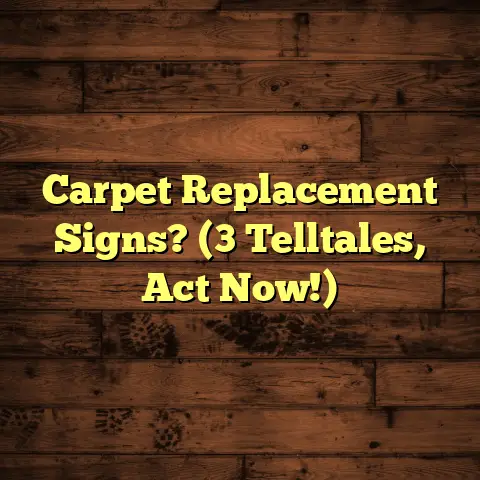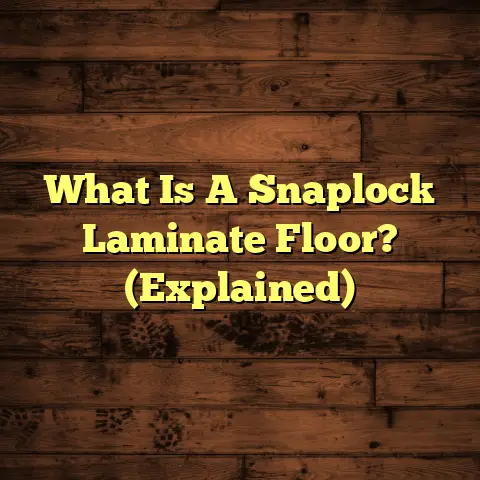Get Glue Off Engineered Flooring? (1-Hour Fix!)
I’ve seen it all – from water damage to pet stains, and yes, even stubborn glue residue on beautiful engineered flooring.
Today, we’re tackling that sticky situation head-on.
You might think getting glue off engineered flooring is a nightmare, but I’m here to tell you it doesn’t have to be!
In fact, with the right approach, you can often get it done in about an hour.
Let’s dive in and get those floors looking their best again!
1. Understanding Engineered Flooring
So, what exactly is engineered flooring?
It’s not solid hardwood, but it’s also a step up from laminate.
Think of it as a multi-layered sandwich.
The top layer is a veneer of real hardwood, giving you that authentic wood look and feel.
Underneath, you’ll find layers of plywood or high-density fiberboard (HDF) that provide stability and prevent warping.
Why choose engineered flooring?
- Stability: It handles moisture and temperature changes better than solid hardwood, making it ideal for basements or kitchens.
- Cost-Effective: Generally less expensive than solid hardwood.
- Easy Installation: Many engineered floors come with click-lock systems, making DIY installation a breeze.
- Versatility: Available in a wide range of wood species, finishes, and plank sizes.
You’ll find engineered flooring in living rooms, bedrooms, hallways, and even some commercial spaces.
Its versatility makes it a popular choice for many homeowners.
2. Identifying the Types of Glue
Alright, Sherlock Holmes, it’s time for a little detective work.
Knowing what kind of glue you’re dealing with is crucial for effective removal.
Here are some common culprits I’ve encountered:
- Polyurethane Adhesive: Strong and water-resistant, often used for permanent installations. This stuff is tough!
- Latex Adhesive: Water-based and easier to clean up when wet, but can become stubbornly sticky when dry.
- Contact Cement: Bonds instantly upon contact, so it’s often used for quick fixes.
Be careful with this one! - Construction Adhesive (like Liquid Nails): This is a heavy-duty adhesive that creates a very strong bond.
It’s often used in construction projects.
How do you tell them apart?
Honestly, it can be tricky. Here are some clues:
- Installation History: Do you remember what adhesive was used during the installation?
If you installed it yourself, check your receipts or notes. - Residue Appearance: Polyurethane tends to be yellowish or brownish.
Latex can be white or clear.
Contact cement is often amber-colored. - Location: Where is the glue?
If it’s around the perimeter of the room, it might be a construction adhesive used for baseboards.
Why does it matter?
Using the wrong removal method can damage your flooring.
For example, harsh solvents might dissolve the finish on the wood veneer.
3. Gathering the Right Tools and Materials
Okay, time to gear up! Here’s what you’ll need for your glue-removal mission.
- Tools:
- Plastic Scraper: Essential!
Metal scrapers can scratch the flooring.
Get a good quality one. - Heat Gun or Hair Dryer: For softening the adhesive.
A heat gun is faster, but be careful not to overheat the floor. - Adhesive Remover: Choose one specifically designed for flooring.
I’ll recommend some below. - Soft Cloths or Sponges: For wiping and cleaning.
- Vacuum Cleaner: For removing debris.
- Putty Knife: For stubborn glue.
- Plastic Scraper: Essential!
- Cleaning Solutions:
- Mineral Spirits: Effective for many types of glue, but test it in an inconspicuous area first!
- Acetone: Use with caution, as it can damage some finishes.
Again, test first! - Dish Soap and Water: For a final clean-up.
- Eco-Friendly Alternatives:
- Vinegar: A mild acid that can help dissolve some adhesives.
- Baking Soda: Can be used as a mild abrasive.
- Safety Equipment:
- Gloves: Protect your hands from chemicals and sticky residue.
- Eye Protection: Safety glasses are a must, especially when using chemical removers.
- Ventilation: Open windows or use a fan to ensure good ventilation.
Recommended Adhesive Removers:
- Goo Gone Adhesive Remover: Works on many surfaces and is relatively gentle.
- Motsenbocker’s Lift Off Adhesive Remover: A professional-grade remover that’s effective on tough adhesives.
- De-Solv-It Citrus Solution: A natural, citrus-based remover that’s a good option for sensitive surfaces.
4. Step-by-Step Guide to Removing Glue
Alright, let’s get down to business!
I’ll walk you through three methods for removing glue, starting with the gentlest and working our way up.
Preparation
- Clear the Area: Remove any furniture, rugs, or other obstacles.
- Protect Surrounding Surfaces: Cover nearby walls or baseboards with painter’s tape.
- Patch Test: This is crucial!
Before applying any remover or heat, test it on a small, inconspicuous area of the floor (like under a piece of furniture).
Wait at least 30 minutes to see if it damages the finish. - Clean the surface: Remove any loose debris or dirt from the area.
Method 1: Using Heat
This method works best for softer adhesives like latex or contact cement.
- Apply Heat: Hold the heat gun or hair dryer a few inches away from the glue residue.
Move it back and forth to avoid overheating one spot. - Soften the Glue: Heat for about 30-60 seconds, or until the glue becomes soft and pliable.
- Scrape Carefully: Use the plastic scraper to gently lift the softened glue.
Work at an angle to avoid scratching the floor. - Repeat: If the glue is stubborn, repeat the heating and scraping process.
- Clean Up: Wipe the area with a damp cloth to remove any remaining residue.
Method 2: Chemical Adhesive Removers
This method is for tougher adhesives that don’t respond to heat.
- Choose the Right Remover: Select an adhesive remover specifically designed for flooring and suitable for the type of glue you’re dealing with.
Always check the manufacturer’s instructions. - Apply the Remover: Apply a small amount of the remover to the glue residue.
- Wait: Let the remover sit for the recommended time (usually 5-15 minutes).
This allows it to penetrate and loosen the adhesive. - Scrape: Use the plastic scraper to gently remove the softened glue.
- Clean Up: Wipe the area with a clean, damp cloth to remove any remaining remover and residue.
You might need to use a mild detergent solution for this step. - Dry: Wipe with a dry cloth.
Method 3: Eco-Friendly Solutions
If you prefer a more natural approach, try these alternatives.
- Vinegar:
- Apply: Soak a cloth in white vinegar and place it over the glue residue.
- Wait: Let it sit for 15-30 minutes.
- Scrape: Use the plastic scraper to remove the softened glue.
- Clean: Wipe with a damp cloth.
- Baking Soda Paste:
- Mix: Make a paste of baking soda and water.
- Apply: Apply the paste to the glue residue.
- Wait: Let it sit for 30-60 minutes.
- Scrub: Gently scrub with a soft cloth or sponge.
- Clean: Wipe with a damp cloth.
Important Considerations:
- Patience is key! Don’t rush the process.
Apply gentle pressure and repeat steps as needed. - Avoid excessive force. You don’t want to damage the floor’s finish.
- Work in small sections. This will help you control the process and prevent the remover from drying out.
5. Post-Removal Care
You’ve conquered the glue! Now, let’s make sure your floors are looking their best.
- Cleaning: After removing the glue, clean the area with a pH-neutral floor cleaner specifically designed for engineered wood floors.
- Buffing: Use a soft cloth or microfiber mop to buff the floor and restore its shine.
- Protection: Consider applying a floor protector or restorer to add a layer of protection and enhance the floor’s appearance.
Recommended Cleaning Solutions:
- Bona Hardwood Floor Cleaner: A popular and effective cleaner for engineered wood floors.
- Armstrong Hardwood and Laminate Floor Cleaner: Another reliable option.
Tips for Preventing Future Adhesive Issues:
- Use the right adhesive: When installing flooring or trim, choose an adhesive specifically designed for engineered wood.
- Apply adhesive sparingly: Avoid over-applying adhesive, as this can lead to excess residue.
- Clean up spills immediately: Wipe up any adhesive spills as soon as they occur.
- Use painter’s tape: When applying adhesive near the floor, use painter’s tape to protect the surface.
6. Case Studies and Real-Life Examples
Let me share a few stories from my years in the field.
Case Study 1: The Sticky Kitchen
A homeowner in Anytown, USA, contacted me after installing a new backsplash in her kitchen.
She accidentally dripped construction adhesive onto her engineered wood floor.
She tried scrubbing it with soap and water, but it only made the problem worse.
I used the heat gun method, followed by a small amount of mineral spirits.
It took about an hour, but we were able to remove the adhesive without damaging the floor.
Case Study 2: The Rental Renovation
A landlord in Smallville, USA, needed to remove old carpet adhesive from an engineered wood floor in a rental property.
The adhesive was old and rock-hard.
We used a combination of chemical adhesive remover and a plastic scraper.
It was a tougher job, but we got it done in a few hours and saved the landlord the cost of replacing the flooring.
Testimonials
“I was so worried when I got glue on my engineered floor.
Mike’s advice saved the day!
The heat gun method worked like a charm.” – Sarah J.
“I tried everything to get the glue off my floor.
The adhesive remover was the only thing that worked.
Thanks, Mike!” – Tom B.
7. Conclusion: Empowering Homeowners
So, there you have it!
Removing glue from engineered flooring might seem daunting, but with the right tools, techniques, and a little patience, you can tackle it yourself.
I’ve shared my best tips and tricks from years of experience.
Don’t be afraid to give it a try!
Remember to always test your methods in an inconspicuous area first, and take your time.
The satisfaction of restoring your beautiful floors is well worth the effort.
Now go forth and conquer that glue!
You got this!





